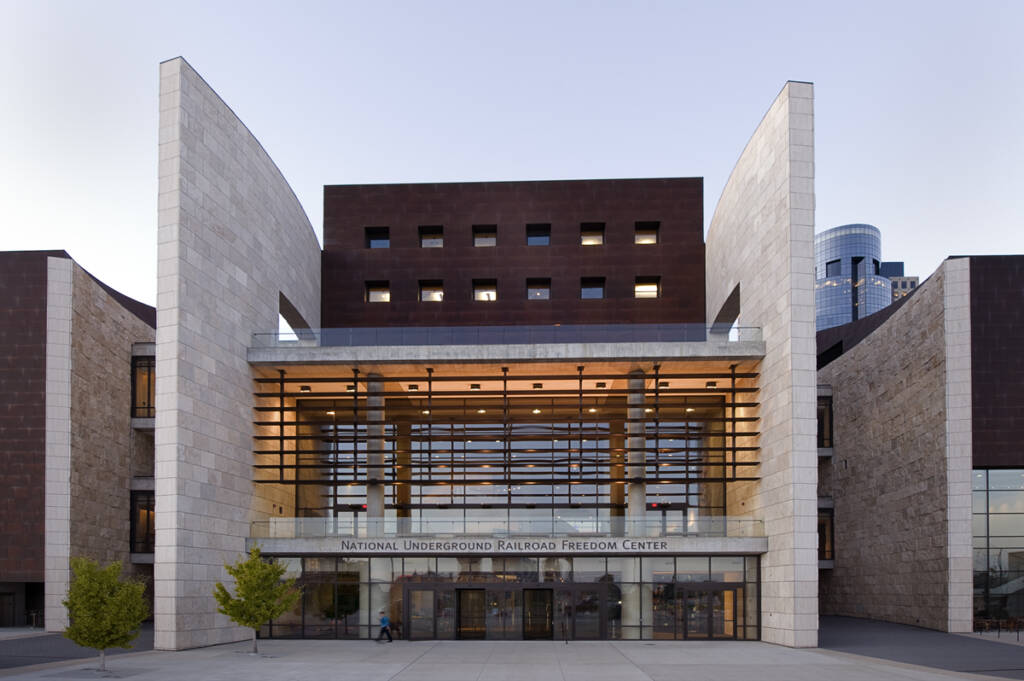The National Underground Railroad Freedom Center, located in Downtown Cincinnati, stands as a powerful testament to the resilience and courage of the individuals who sought freedom from the bonds of slavery. This museum, which opened its doors in 2004, not only chronicles the history of the Underground Railroad but also serves as a beacon of hope, advocating for contemporary human rights and social justice issues. In this article, we will delve into the rich history and significance of the National Underground Railroad Freedom Center and how it continues to inspire generations today.
History and Location
Cincinnati, situated along the banks of the Ohio River, was a vital hub during the 19th century for those escaping slavery. The river marked a natural boundary between the free states in the North and the slaveholding states in the South, making the city a strategic location for the Underground Railroad. The Freedom Center stands proudly near this historic location, in the heart of downtown Cincinnati.
The idea for the National Underground Railroad Freedom Center was first conceived in the 1990s, with the goal of creating an institution that would preserve the legacy of the Underground Railroad and promote a greater understanding of the ongoing struggle for freedom worldwide. After several years of planning and fundraising, the $110 million facility was finally completed, and it has since become a vital educational resource and cultural destination.
The Architecture and Design of the National Underground Railroad Freedom Center
The National Underground Railroad Freedom Center stands out as an architectural marvel, with its design embodying the themes of courage, cooperation, and perseverance that underpin the history of the Underground Railroad. The museum, which spans 158,000 square feet, was designed by the renowned architecture firm Blackburn Architects in collaboration with BOORA Architects.
The exterior of the building features striking design elements, such as the 800-foot-long “Freedom Wall,” which consists of a series of textured, undulating panels representing the rippling waters of the Ohio River. The wall symbolizes the river’s role as a natural boundary between freedom and slavery and serves as a reminder of the treacherous journeys made by countless individuals seeking a better life.
Another prominent feature of the Freedom Center’s architecture is the “Eternal Flame,” a sculptural installation that stands tall at the entrance of the museum. Designed by artist and sculptor Tony Cragg, the Eternal Flame represents the unwavering human spirit and the enduring quest for freedom. It serves as a beacon of hope and an invitation to visitors to reflect on the powerful stories of resistance and liberation that the museum showcases.
Inside the building, the design elements continue to reflect the themes of the Underground Railroad. The main exhibition spaces, connected by a series of ramps and bridges, symbolize the various safe houses and pathways that were integral to the network of escape routes. The use of natural materials, such as wood and stone, alongside modern glass and steel, creates a visually stunning and thought-provoking atmosphere that encourages visitors to immerse themselves in the poignant narratives of the past.
The National Underground Railroad Freedom Center demonstrates the power of architecture to convey a message and evoke emotion. Its design serves as an integral part of the museum experience, inspiring visitors to delve deeper into the complex history of the Underground Railroad and the ongoing pursuit of freedom and human rights.
Exhibitions and Features
The National Underground Railroad Freedom Center hosts a variety of permanent and temporary exhibits that tell the stories of the brave men, women, and children who risked everything in their pursuit of freedom. Some of the center’s notable permanent exhibitions include:
- The Slave Pen: A sobering reminder of the brutal reality of the slave trade, this original 1800s slave pen was once used to house enslaved people before they were sold at auctions. The pen has been carefully preserved and reconstructed within the museum to offer visitors an intimate look into the inhumane conditions endured by countless individuals.
- Brothers of the Borderland: This immersive theater experience, narrated by Oprah Winfrey, transports visitors back in time to the 1850s, where they can witness the heroism of Underground Railroad conductors like John Parker and Reverend John Rankin.
- Invisible: Slavery Today: This interactive exhibit sheds light on modern-day slavery and human trafficking, highlighting the fact that the fight for freedom is far from over.
- The Struggle Continues: This exhibit explores the ongoing battle for civil rights in America, showcasing the events and individuals that have shaped the country’s struggle for equality and justice.
Educational Programs and Community Outreach
The National Underground Railroad Freedom Center is dedicated to fostering an ongoing dialogue about the importance of freedom and human rights. Through a variety of educational programs, workshops, and community events, the center engages visitors of all ages in the conversation. These programs aim to promote an understanding of the past and inspire action to address contemporary challenges related to social justice, equality, and human dignity.
Notable Figures of the Underground Railroad: Stories of Courage and Sacrifice
The Underground Railroad was a clandestine network of safe houses, secret routes, and brave individuals who risked their lives to assist enslaved people in their escape to freedom. This section highlights some of the most notable figures who played critical roles in the success of the Underground Railroad, showcasing their inspiring stories of courage and sacrifice.
- Harriet Tubman: Known as the “Moses of her people,” Harriet Tubman was an escaped slave who became a conductor on the Underground Railroad. Over the course of a decade, Tubman led more than 300 enslaved people to freedom, including her own family members. Her unwavering determination and exceptional skills in navigation and evasion made her a legendary figure in American history.
- Frederick Douglass: A prominent abolitionist, writer, and speaker, Frederick Douglass was a former slave who became an influential leader in the fight against slavery. His eloquent speeches and writings brought attention to the brutal reality of slavery, and he used his prominence to support the Underground Railroad by offering his home in Rochester, New York, as a safe house for fugitive slaves.
- Levi Coffin: Often referred to as the “President of the Underground Railroad,” Levi Coffin was a Quaker abolitionist who, along with his wife Catharine, provided shelter, food, and assistance to thousands of escaping slaves. Their home in Indiana became known as “Grand Central Station” of the Underground Railroad due to the sheer number of individuals they helped along their journey to freedom.
- John Parker: A former slave who bought his own freedom, John Parker became a successful businessman and an active conductor on the Underground Railroad. He risked his life numerous times by crossing the Ohio River into slaveholding states to guide fugitives to safety. His story is featured in the National Underground Railroad Freedom Center’s immersive theater experience, “Brothers of the Borderland.”
- Reverend John Rankin: A Presbyterian minister and dedicated abolitionist, Reverend John Rankin, along with his wife Jean, provided shelter and assistance to over 2,000 fugitive slaves at their home in Ripley, Ohio. Rankin’s house, perched on a hill overlooking the Ohio River, served as a beacon of hope for those seeking freedom.
These remarkable individuals represent just a fraction of the countless men and women who risked everything to help enslaved people find their way to freedom. Their stories of courage, determination, and selflessness continue to inspire and educate visitors at the National Underground Railroad Freedom Center, ensuring that the legacy of the Underground Railroad endures for generations to come.
Cincinnati’s Role in the Underground Railroad: A Gateway to Freedom
Cincinnati, Ohio, played a crucial role in the history of the Underground Railroad, serving as a critical waypoint for fugitive slaves on their path to freedom. The city’s strategic location along the Ohio River made it a natural gateway between the slaveholding states of the South and the free states of the North. In this section, we explore the significance of Cincinnati in the Underground Railroad and the reasons why the National Underground Railroad Freedom Center was established in this historic city.
- The Ohio River: The Ohio River served as a natural boundary between freedom and slavery, with the southern shore belonging to the slave states of Kentucky and Virginia, while the northern shore was part of the free state of Ohio. Escaping slaves would often travel by night, guided by the North Star, to reach the river and cross over to the safety of Ohio.
- Safe Houses and Conductors: Many residents of Cincinnati, both black and white, were active participants in the Underground Railroad. They provided food, shelter, and guidance to fugitive slaves, often at great personal risk. Some of the city’s most well-known conductors included John Parker, Reverend John Rankin, and the Coffin family. Additionally, churches, businesses, and private homes served as safe houses and hiding places for those seeking freedom.
- Vigilance Committees: Vigilance committees were established in Cincinnati to organize and coordinate the efforts of those involved in the Underground Railroad. These committees consisted of local abolitionists and free black residents who worked together to provide assistance and protection to escaping slaves. They also gathered intelligence on slave catchers and kidnappers, helping to ensure the safety of those on the run.
- The Struggles and Conflicts: Cincinnati’s position as a border city between North and South meant that it was also a site of tension and conflict. Pro-slavery advocates and slave catchers were active in the city, often clashing with abolitionists and the free black community. Despite the dangers, the people of Cincinnati remained steadfast in their commitment to the cause of freedom.
The establishment of the National Underground Railroad Freedom Center in Cincinnati serves as a powerful testament to the city’s vital role in the struggle for freedom. By preserving the stories and experiences of those who participated in the Underground Railroad, the Freedom Center ensures that the legacy of Cincinnati’s courageous residents will continue to inspire and educate generations to come.
The Legacy of the Underground Railroad: How It Shaped American History
The Underground Railroad, while not an actual railroad, was a vital network of secret routes, safe houses, and courageous individuals who assisted thousands of enslaved people in their escape to freedom. The legacy of the Underground Railroad extends far beyond the individual lives it touched; it had a profound impact on American history, shaping the nation’s social, political, and cultural landscape. This section delves into the ways the Underground Railroad left a lasting imprint on the United States.
- The Abolitionist Movement: The Underground Railroad played a pivotal role in galvanizing support for the abolitionist movement in the United States. The inspiring stories of those who risked their lives for freedom, as well as the bravery and selflessness of the conductors, helped to raise public awareness of the horrors of slavery and fueled the drive for change. Many key figures in the Underground Railroad, such as Harriet Tubman and Frederick Douglass, became influential voices for abolition and champions for human rights.
- Legal and Political Ramifications: The success of the Underground Railroad in helping enslaved people escape to freedom led to increased tensions between the North and South, exacerbating the divide that would eventually lead to the Civil War. In response to the effectiveness of the Underground Railroad, the Fugitive Slave Act of 1850 was passed, which sought to punish those who aided escaping slaves and required the return of fugitive slaves to their owners. This legislation further ignited the debate over slavery and states’ rights, contributing to the growing rift between pro-slavery and anti-slavery factions.
- The Role of Women and African Americans: The Underground Railroad provided an avenue for women and African Americans to take on leadership roles and demonstrate their courage and resourcefulness. Harriet Tubman, Sojourner Truth, and other female conductors and abolitionists played a significant part in the Underground Railroad’s success, defying societal expectations and shattering stereotypes. The involvement of African Americans, both free and enslaved, showcased their resilience and determination in the face of adversity, inspiring generations to come.
- Cultural and Literary Impact: The Underground Railroad left an indelible mark on American culture and literature. The experiences of those who participated in the Underground Railroad, as well as the broader themes of courage, sacrifice, and the pursuit of freedom, have been immortalized in countless books, poems, songs, and works of art. Works such as Uncle Tom’s Cabin by Harriet Beecher Stowe and the autobiographies of Frederick Douglass brought the plight of enslaved people and the heroism of the Underground Railroad to the forefront of public consciousness.
The legacy of the Underground Railroad is an integral part of American history, highlighting the nation’s capacity for bravery, compassion, and the relentless pursuit of freedom. The National Underground Railroad Freedom Center stands as a monument to this important chapter in history, ensuring that the stories of the Underground Railroad continue to inspire and educate future generations.
Planning Your Visit: Accessibility, Hours of Operation, and Ticket Information
Visiting the National Underground Railroad Freedom Center is a must for anyone interested in American history and the ongoing struggle for human rights. To make the most of your visit, it is essential to know about accessibility, hours of operation, and ticket information. This section provides an overview of what you need to know before planning your trip to the Freedom Center.
- Accessibility: The National Underground Railroad Freedom Center is committed to ensuring that all visitors have a positive and inclusive experience. The museum is fully accessible, with wheelchair-accessible entrances, restrooms, elevators, and ramps throughout the facility. Wheelchairs are available free of charge on a first-come, first-served basis. Additionally, the Freedom Center offers large-print guides, assistive listening devices, and captioning for select exhibits to accommodate visitors with visual and hearing impairments.
- Hours of Operation: The National Underground Railroad Freedom Center is open to the public Tuesday through Saturday, from 10:00 am to 5:00 pm. The museum is closed on Sundays, Mondays, and major holidays. It is recommended that visitors allow at least 2-3 hours to fully explore the museum’s exhibits and interactive experiences.
- Ticket Information: General admission tickets for the National Underground Railroad Freedom Center can be purchased online or at the museum’s ticket counter. Discounts are available for seniors, students, military personnel, and groups of 15 or more. Admission prices are as follows (as of September 2021, prices may change):
- Adults: $15.00
- Seniors (60+): $13.00
- Children (3-12): $10.50
- Children (under 3): Free
- Military (active/retired with ID): $13.00
- Group Visits and School Tours: The National Underground Railroad Freedom Center welcomes groups and school tours, offering discounted rates and guided tour options. Reservations for group visits and school tours should be made at least two weeks in advance. For more information on group visits and educational resources, visit the museum’s website or contact their Group Sales department.
- Location and Parking: The National Underground Railroad Freedom Center is located in downtown Cincinnati’s The Banks neighborhood, at 50 East Freedom Way, Cincinnati, OH 45202. There are several parking options available nearby, including metered street parking and parking garages within walking distance of the museum.
By planning your visit in advance, you can ensure a smooth and enjoyable experience at the National Underground Railroad Freedom Center, taking full advantage of the museum’s powerful exhibits, engaging programs, and educational resources.
Conclusion
The National Underground Railroad Freedom Center stands as an enduring symbol of hope, courage, and the indomitable human spirit. By preserving the legacy of the Underground Railroad and promoting awareness of modern-day struggles, the center serves as a reminder that the pursuit of freedom is a timeless and essential endeavor. As a living monument to those who fought for their freedom, the National Underground Railroad Freedom Center invites visitors to reflect on the past and take part in building a more just and equitable future.







3 thoughts on “A Journey Through History: The National Underground Railroad Freedom Center”